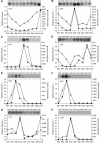Gene discovery and expression profile analysis through sequencing of expressed sequence tags from different developmental stages of the chytridiomycete Blastocladiella emersonii
- PMID: 15701807
- PMCID: PMC549328
- DOI: 10.1128/EC.4.2.455-464.2005
Gene discovery and expression profile analysis through sequencing of expressed sequence tags from different developmental stages of the chytridiomycete Blastocladiella emersonii
Abstract
Blastocladiella emersonii is an aquatic fungus of the chytridiomycete class which diverged early from the fungal lineage and is notable for the morphogenetic processes which occur during its life cycle. Its particular taxonomic position makes this fungus an interesting system to be considered when investigating phylogenetic relationships and studying the biology of lower fungi. To contribute to the understanding of the complexity of the B. emersonii genome, we present here a survey of expressed sequence tags (ESTs) from various stages of the fungal development. Nearly 20,000 cDNA clones from 10 different libraries were partially sequenced from their 5' end, yielding 16,984 high-quality ESTs. These ESTs were assembled into 4,873 putative transcripts, of which 48% presented no matches with existing sequences in public databases. As a result of Gene Ontology (GO) project annotation, 1,680 ESTs (35%) were classified into biological processes of the GO structure, with transcription and RNA processing, protein biosynthesis, and transport as prevalent processes. We also report full-length sequences, useful for construction of molecular phylogenies, and several ESTs that showed high similarity with known proteins, some of which were not previously described in fungi. Furthermore, we analyzed the expression profile (digital Northern analysis) of each transcript throughout the life cycle of the fungus using Bayesian statistics. The in silico approach was validated by Northern blot analysis with good agreement between the two methodologies.
Figures




Similar articles
-
Transcriptome analysis in response to heat shock and cadmium in the aquatic fungus Blastocladiella emersonii.Eukaryot Cell. 2007 Jun;6(6):1053-62. doi: 10.1128/EC.00053-07. Epub 2007 Apr 20. Eukaryot Cell. 2007. PMID: 17449658 Free PMC article.
-
Global gene expression analysis during germination in the chytridiomycete Blastocladiella emersonii.Eukaryot Cell. 2009 Feb;8(2):170-80. doi: 10.1128/EC.00330-08. Epub 2008 Dec 19. Eukaryot Cell. 2009. PMID: 19098129 Free PMC article.
-
Environmental stresses inhibit splicing in the aquatic fungus Blastocladiella emersonii.BMC Microbiol. 2009 Oct 29;9:231. doi: 10.1186/1471-2180-9-231. BMC Microbiol. 2009. PMID: 19874600 Free PMC article.
-
Comparative EST analysis provides insights into the basal aquatic fungus Blastocladiella emersonii.BMC Genomics. 2006 Jul 12;7:177. doi: 10.1186/1471-2164-7-177. BMC Genomics. 2006. PMID: 16836762 Free PMC article.
-
Gene identification through large-scale EST sequence processing.Appl Bioinformatics. 2003;2(3):123-9. Appl Bioinformatics. 2003. PMID: 15130797 Review.
Cited by
-
Transcriptome analysis in response to heat shock and cadmium in the aquatic fungus Blastocladiella emersonii.Eukaryot Cell. 2007 Jun;6(6):1053-62. doi: 10.1128/EC.00053-07. Epub 2007 Apr 20. Eukaryot Cell. 2007. PMID: 17449658 Free PMC article.
-
Global gene expression analysis during germination in the chytridiomycete Blastocladiella emersonii.Eukaryot Cell. 2009 Feb;8(2):170-80. doi: 10.1128/EC.00330-08. Epub 2008 Dec 19. Eukaryot Cell. 2009. PMID: 19098129 Free PMC article.
-
A rhodopsin-guanylyl cyclase gene fusion functions in visual perception in a fungus.Curr Biol. 2014 Jun 2;24(11):1234-40. doi: 10.1016/j.cub.2014.04.009. Epub 2014 May 15. Curr Biol. 2014. PMID: 24835457 Free PMC article.
-
Two origins for the gene encoding alpha-isopropylmalate synthase in fungi.PLoS One. 2010 Jul 15;5(7):e11605. doi: 10.1371/journal.pone.0011605. PLoS One. 2010. PMID: 20657649 Free PMC article.
-
Environmental stresses inhibit splicing in the aquatic fungus Blastocladiella emersonii.BMC Microbiol. 2009 Oct 29;9:231. doi: 10.1186/1471-2180-9-231. BMC Microbiol. 2009. PMID: 19874600 Free PMC article.
References
-
- Bishop, J. O., J. G. Morton, M. Rosbash, and M. Richardson. 1974. Three abundance classes in HeLa cell messenger RNA. Nature 250:199-204. - PubMed
-
- de Oliveira, J. C., A. C. Borges, M. V. Marques, and S. L. Gomes. 1994. Cloning and characterization of the gene for the catalytic subunit of cAMP-dependent protein kinase in the aquatic fungus Blastocladiella emersonii. Eur. J. Biochem. 219:555-562. - PubMed
-
- de Souza, F. S., and S. L. Gomes. 1998. A P-type ATPase from the aquatic fungus Blastocladiella emersonii similar to animal Na, K-ATPases. Biochim. Biophys. Acta 1383:183-187. - PubMed
Publication types
MeSH terms
LinkOut - more resources
Full Text Sources
Research Materials

